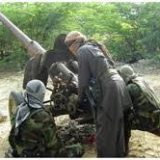Sign art in Somaliland: Walls and their stories in Hargeisa
Hand-painted signs in Hargeisa are beautiful, unique and everywhere.
“I never took pictures of billboards back in the U.S. but here that’s pretty much all I photograph,” says Naqib, a returning Somali diaspora in a teahouse in downtown Hargeisa. He has lived in the West for decades and, as an outsider, is more sensitive to the mastery in the hand-painted artwork.
There are hundreds of vibrant paintings on the walls of little shops, barbers and restaurants. Foreigners who visit Somaliland’s capital, Hargeisa, are often surprised by how “visual” the city is. The saturation, vitality and style of the paintings are captivating from a cultural and also artistic viewpoint.
A wide-open mouth showing shiny teeth outside a dentist, a lion holding a camera on the wall of a photo studio or a grocery store with the whole stock painted on its front – from Lipton Yellow Label Tea to Kellogg’s Cornflakes. The wall painting of a small neighborhood restaurant makes one crave camel meat with pasta more than a photograph ever could.
In most cases sign paintings are a purely functional. They advertise a business and show pedestrians what’s on stock. However, the exteriors and interiors of a lot of restaurants are embellished with very imaginative landscapes. In both cases the refined paintings are often great compositions and have a unique texture given by the surface they are painted on.
Why images speak louder than words on the streets of Hargeisa has a simple reason: Illiteracy used to be a big problem and people had to see rather than read what the respective business had to offer.
Hanad, one of over a dozen self-taught sign painters in Hargeisa, remembers how artists began painting on the ruins, after they returned from the end of the civil war. Some of them even drew their history as a way to deal with their hard past. “Doing art cooled them down,” says Naqib. He passionately describes a long-gone painting on a school wall in the outer city, as it showed the history of the sixties, and the scene of the planes bombing Hargeisa in 1989. Today vibrant paintings contrast the rough walls and sand roads of Hargeisa, a rising but still under-developed city in this breakaway state.
Unfortunately, artists and residents seem unaware of the beauty and uniqueness of the art on their streets. For them the paintings are just functional and not considered an integral part of Hargeisa’s look – and certainly not art. On top of that sign painting is a fading practice. Often poorly designed, printed signs have slowly taken over paintings.
An artsy American working for the World Bank in Hargeisa quotes the Arabic proverb, “The donkey doesn’t know the value of the honey on his back.” He attaches great value to the paintings and hopes the hard-working Hargeisa residents will grow to see the rich heritage they have in what feels to many like an arduous, underpaid trade.
![“Sarifka Lacagaha" (Money Exchange) – sidewall of grocery store that also provides money exchange services and sells mobile phone top up cards. [Philip Schütz / Sahan Journal]](http://mukhtaryare.wpengine.netdna-cdn.com/wp-content/uploads/2015/04/01-500x333.jpg)
![Vibrant exterior of a small eatery
. [Philip Schütz / Sahan Journal]](http://mukhtaryare.wpengine.netdna-cdn.com/wp-content/uploads/2015/04/02-500x333.jpg)
![The sidewall of a restaurant exhibits Somali food at its finest. [Philip Schütz / Sahan Journal]](http://mukhtaryare.wpengine.netdna-cdn.com/wp-content/uploads/2015/04/03-500x323.jpg)
![Naïve art outside an eatery. [Philip Schütz / Sahan Journal]](http://mukhtaryare.wpengine.netdna-cdn.com/wp-content/uploads/2015/04/04-500x538.jpg)
![Hanad, a sign painter, is painting a shop wall in the outskirts of Hargeisa. Clients usually contact him via his phone number, which he always writes on his paintings together with his business name, Hanad Arts. [Philip Schütz / Sahan Journal]](http://mukhtaryare.wpengine.netdna-cdn.com/wp-content/uploads/2015/04/06-500x375.jpg)
Philipp Schütz is currently working on a photo book about wall paintings in Hargeisa and life in the city in general. This photo essay will appear in the upcoming “Modern Nomads” Journal due for publication in mid-2015. You can pre-order your copy here.



















